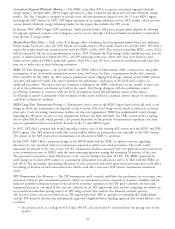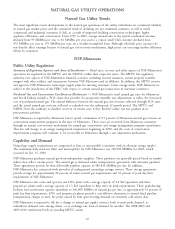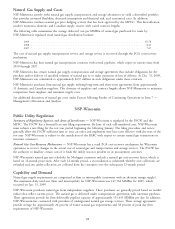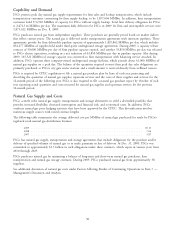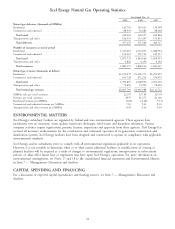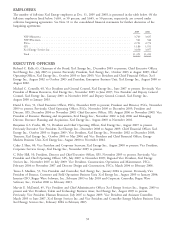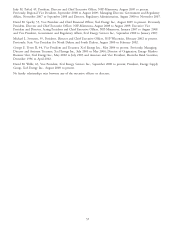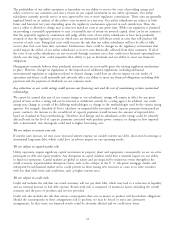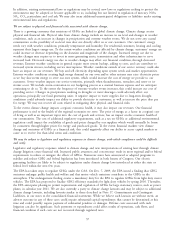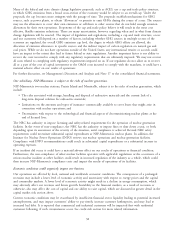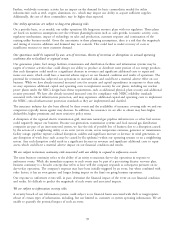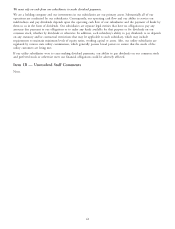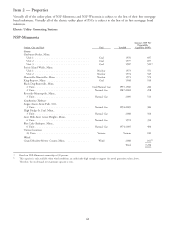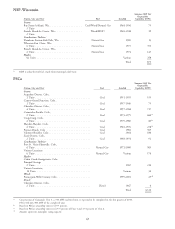Xcel Energy 2009 Annual Report Download - page 45
Download and view the complete annual report
Please find page 45 of the 2009 Xcel Energy annual report below. You can navigate through the pages in the report by either clicking on the pages listed below, or by using the keyword search tool below to find specific information within the annual report.The profitability of our utility operations is dependent on our ability to recover the costs of providing energy and
utility services to our customers and earn a return on our capital investment in our utility operations. Our utility
subsidiaries currently provide service at rates approved by one or more regulatory commissions. These rates are generally
regulated based on an analysis of the utility’s costs incurred in a test year. Our utility subsidiaries are subject to both
future and historical test years depending upon the regulatory mechanisms approved in each jurisdiction. Thus, the
rates a utility is allowed to charge may or may not match its costs at any given time. While rate regulation is premised
on providing a reasonable opportunity to earn a reasonable rate of return on invested capital, there can be no assurance
that the applicable regulatory commission will judge all the costs of our utility subsidiaries to have been prudently
incurred or that the regulatory process in which rates are determined will always result in rates that will produce full
recovery of such costs. Rising fuel costs could increase the risk that our utility subsidiaries will not be able to fully
recover their fuel costs from their customers. Furthermore, there could be changes in the regulatory environment that
would impair the ability of our utility subsidiaries to recover costs historically collected from their customers. If all of
the costs of our utility subsidiaries are not recovered through customer rates, they could incur financial operating losses,
which, over the long term, could jeopardize their ability to pay us dividends and our ability to meet our financial
obligations.
Management currently believes these prudently incurred costs are recoverable given the existing regulatory mechanisms
in place. However, changes in regulations or the imposition of additional regulations, including additional
environmental regulation or regulation related to climate change, could have an adverse impact on our results of
operations and hence could materially and adversely affect our ability to meet our financial obligations, including debt
payments and the payment of dividends on our common stock.
Any reductions in our credit ratings could increase our financing costs and the cost of maintaining certain contractual
relationships.
We cannot be assured that any of our current ratings or our subsidiaries’ ratings will remain in effect for any given
period of time or that a rating will not be lowered or withdrawn entirely by a rating agency. In addition, our credit
ratings may change as a result of the differing methodologies or change in the methodologies used by the various rating
agencies. For example, Standard & Poor’s calculates an imputed debt associated with capacity payments from purchase
power contracts. An increase in the overall level of capacity payments would increase the amount of imputed debt,
based on Standard & Poor’s methodology. Therefore, Xcel Energy and its subsidiaries credit ratings could be adversely
affected based on the level of capacity payments associated with purchase power contracts or changes in how imputed
debt is determined. Any downgrade could lead to higher borrowing costs.
We are subject to interest rate risk.
If interest rates increase, we may incur increased interest expense on variable interest rate debt, short-term borrowings or
incremental long-term debt, which could have an adverse impact on our operating results.
We are subject to capital market risk.
Utility operations require significant capital investment in property, plant and equipment; consequently, we are an active
participant in debt and equity markets. Any disruption in capital markets could have a material impact on our ability
to fund our operations. Capital markets are global in nature and are impacted by numerous events throughout the
world economy. Capital market disruption events, such as the collapse in the U. S. sub-prime mortgage market and
subsequent broad financial market stress, could prevent us from issuing new securities or cause us to issue securities
with less than ideal terms and conditions, such as higher interest rates.
We are subject to credit risks.
Credit risk includes the risk that our retail customers will not pay their bills, which may lead to a reduction in liquidity
and an eventual increase in bad debt expense. Retail credit risk is comprised of numerous factors including the overall
economy and the price of products and services provided.
Credit risk also includes the risk that various counterparties that owe us money or product will breach their obligations.
Should the counterparties to these arrangements fail to perform, we may be forced to enter into alternative
arrangements. In that event, our financial results could be adversely affected and we could incur losses.
35


